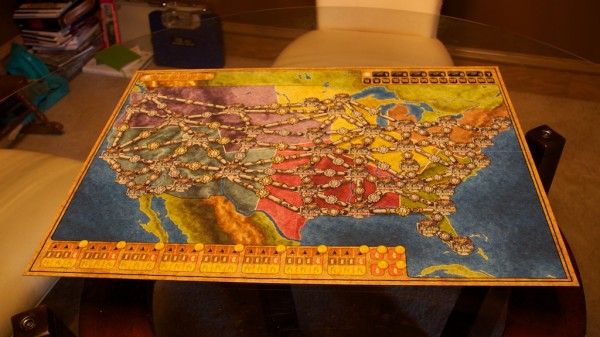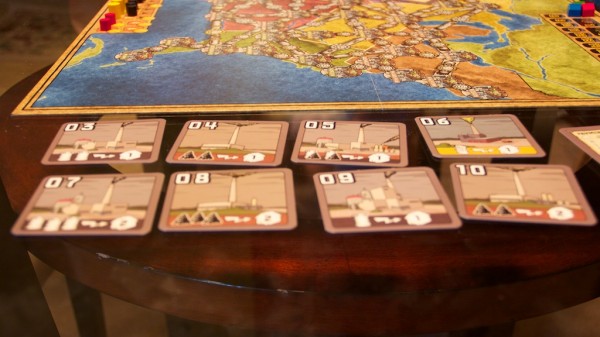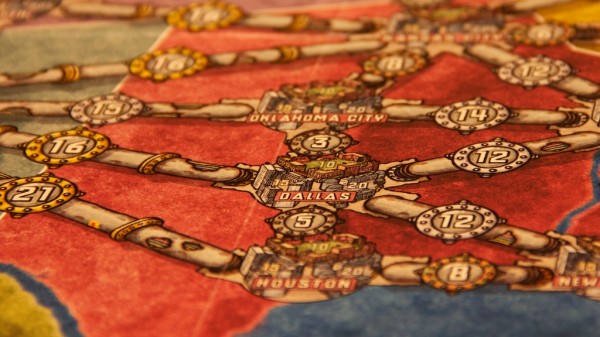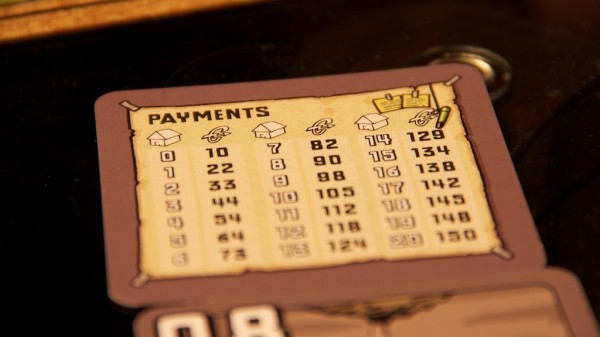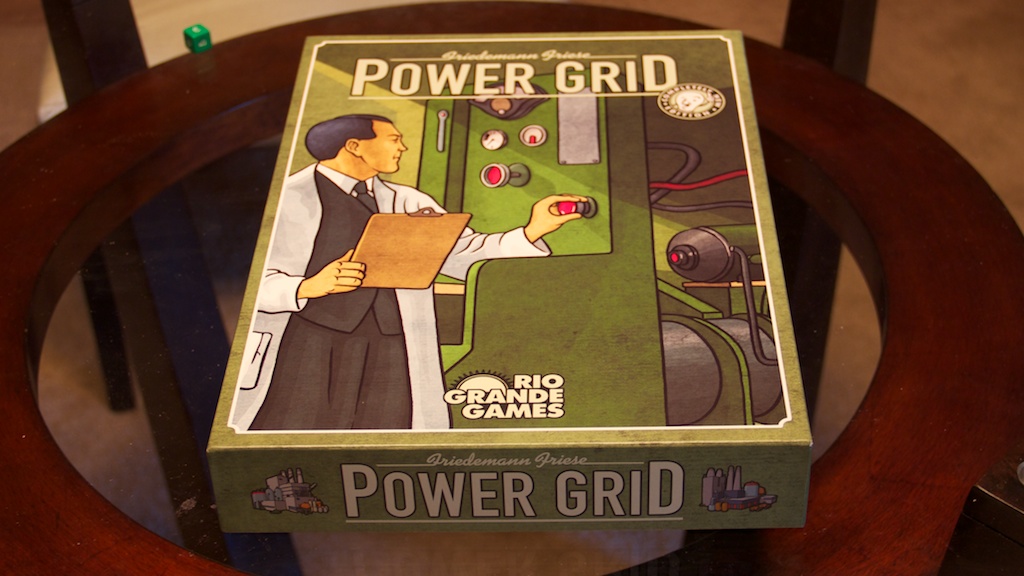
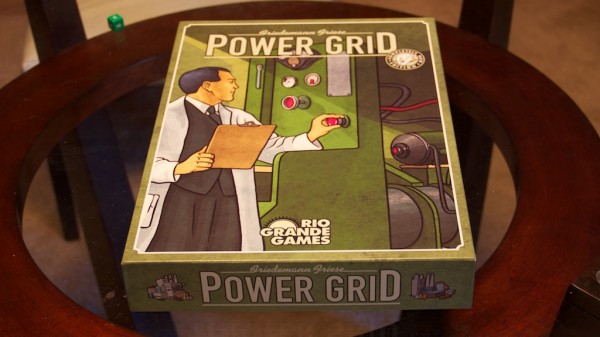
On a website that deals mainly with video games and online streaming, it might seem strange that there have been all of these reviews about board games, but here we are. Lately, we have been consumed games that do not have ON switches, so it might be a little ironic that our latest board game is all about electricity, Power Grid.
The basic goal of Power Grid is this: get your electric power into more cities than everyone else and do it as fast as you can. Also, you can be a jerk about it. Being a jerk about it happens a lot, so just get used to it. The rules for winning the game change based on how many people are in play, which generally comes down to the amount of cities you need to win.
The game itself includes a two-sided board with a map of America on one side and a map of Germany on the other. There are upwards of forty power plant cards, and tons of wooden resource tokens available to purchase with Monopoly-esque money. Up to six players begin by choosing one of six large territories on a map of either America or Germany. Several cities are scattered around the board connected by pipelines. Immediately after choosing a territory, players begin the general turn order.
Firstly, the aforementioned power plants are bid on. Displayed in a 4×2 grid, players – once turn order is established – bid on the top line of power plants available. This represents the Current Market. The bottom four plants reside in the Future Market, and are basically visible to add to the strategy of determining what you want to bid on right now verses later on. When a plant is purchased, the first Future Market plant moves up to the Current Market, and a new plant is placed at the end of the list. This first turn of the round is a perilous one because turn order changes based on how many cities a player owns. One round you might go first with the bidding, the next last. Depending on what is available in the Current Market, going first is either awesome or awful. The other players will inevitably try to outbid you on the good plants, and force you to pay much more than what you wanted to originally. You do have the option to pass on bidding when it comes to your turn, but if you do you cannot purchase any other plants once you bow out. The value of the plants is listed in the top corner of the card, and below that how many resources it takes to power X amount of cities. Although owning a certain amount of cities is paramount to winning the game, powering those cities is essential to build your empire, and to do that you will need to buy dirty, disgusting natural resources.
After you have finished yelling at your friends for buying the good coal plant, the next phase in an overall round is the purchasing of the spoils of a raped Mother Earth. The four energy sources you can buy are coal, oil, garbage, and nuclear power, and these are placed conveniently on a chart to the side of the board. At the start of the game, these resources are generally fairly inexpensive, but as they are bought the price grows and grows. Oil and coal are broken up into sections of three, so the first three coal, for example, only cost one dollar a piece. The next three: two dollars; and so forth. Garbage is listed in sets of two, and nuclear, one. The real catch about this buying phase is that the first person who gets to choose is last in the turn order. If you were going first in the plant buying phase and that coal plant you spent half your money is really awesome, get prepared to spend even more on resources because there’s a good chance other people have already bought a ton of what you want. It sucks, I promise. But such is life when you are in the lead. When you think about it, it’s a great way of balancing the game, but it sure does suck to spend five bucks on a barrel of oil.
Next in line after you have attempted to make intelligent decisions on what will happen comes the phase where you get to spread your influence among the people starving for power. Or in other words you finally get to play on the map. This phase, like the last, has the players going in reverse order. Whoever is currently in last place gets to go first, to the chagrin of everyone else. With whatever remaining money you have from your spending sprees, you begin to link up cities that are under your influence via the pipes. Each player gets a couple dozen house tokens – representing your influence – in their color that can be played in the cities. The first person to land in a city has to pay ten dollars to do so, the second fifteen, and third twenty. Cities can only accept three different players total, and you cannot buy all three slots yourself. Where the difficulty comes in is in planning your route. From your starting city, if you want to head somewhere else, you have to follow the pipes, and the pipes have a cost associated with using them. For example, if you wanted to go from Oklahoma City to Dallas, the cost to place your token there would be ten bucks, but the pipe in between is three, so total to get to Dallas would be thirteen dollars. It’s simple enough, but once people start spreading about, planning the cheapest and most effective route becomes challenging. Compound that by the fact that there are three separate stages in the game that correspond to how many people can occupy a space, and the game board quickly becomes rife with strife. Players can and will get locked into areas until time in the game allows for them to be the second person in a city. And then you have fistfights with your friends.
Amongst bloody noses and black eyes comes the fourth and final phase of the overal one turn: the powering phase. Here you use any of the resources you bought in phase two in conjunction with the power plant you bought in phase one to power the cities you started controlling in phase three. Powering cities is what gets you more money, and, of course, helps you buy more crap next turn. If you have a plant that can power two cities but you have three total cities, well, I’m sorry, but only two of those cities get powered. That may sound like a bad choice, but there are a number of factors as to why you’d want to buy more than you can power (mostly that you either want to go first next turn or you wanted to get to a city on the cheap before someone else did). It’s all strategy, people. Every turn is filthy with it.
And that’s basically the game. As of this writing I have played only two full games, but I have certainly had a lot of fun. Conversations can get heated to the max if you let them, but that may also be the group of people I generally play games with. From what I understand, even though the game already gives you two full boards to play with, there are expansions that add even more maps and rules and craziness.
On the whole, the game feels like a bastard-child mashup of Risk and Monopoly, but more fun and takes less time than either of those games. Currently you can swing Power Grid for about $33 from Amazon. Do it.
